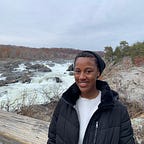Nature and art (at their best) both have ways of grounding onlookers to the present moment, at times invoking silence as one tries to process their simultaneous existence. Moses Sumney’s Blackalachia — an hour-plus long performance film set in the rolling hills of the Blue Ridge Mountains — fuses both with synergistic effects. Genre-bending selections from grae and Aromanticism trapeze through feelings of loneliness, isolation, compartmentalization, rejection, and the like — feelings that many struggle to express to loved ones (or even well-meaning licensed professionals), let alone present them to the entire world.
Given the sensitivity of Sumney’s work, the siting of the performance in Blue Ridge seems like a natural fit. I personally gravitate to the outdoors when dealing with life’s rough patches, when seemingly endless tears call for the company of a nearby lake to make me feel seen and understood. From the film’s opening scenes of the mountainous backdrop, lingering shots of wildflowers and a foraging Eastern Black Swallowtail, it quickly becomes clear that the landscape itself will be an active audience during this confessional.
VULNERABILITY IN THE OUTDOORS
There is a sense of vulnerability that comes with remote environments like the Appalachian Mountains — their expansive beauty coincides with the reality that you are a visitor, exposed, in an ecosystem where you are undoubtably outnumbered and capable of being outsmarted at any given moment. For groups that have been historically barred/erased from or terrorized in those spaces, it can multiply the layers of discomfort. But for those that do feel comfortable venturing out, an unmatched tranquility can be found interwoven throughout, too.
During the film, Sumney melts his layers until laid bare — in sunbaths in a porcelain tub, covered in marigolds while musing about being in an isolated state; in cooler moments writhing in a grass bed under the darkness of night, as if the blades themselves hold the answer to his questioning of a doomed existence. With each layer, there’s a renewed feeling that the viewer has been allowed to witness an intimate conversation between Sumney, the band and the surrounding universe. The communion between them builds until they’re indistinguishable, with Sumney embodying the firmament, shimmering like the clear, starry night sky above him in Bystanders — an ascension that answers Sumney’s voiced frustrations with a reminder that we are all a part of something much bigger than ourselves.
BLACKNESS IN THE OUTDOORS
Blackalachia contrasts the long-standing notion of the United States’ environmental movement that certain people must be separated from so-called “wild” landscapes to preserve their pristine nature. The outdoors were once seen as a place for elite white men to escape the poverty, disease and disorder that often afflicted cities, and to prove their manhood through ownership (i.e., theft) of land, subsequently displacing existing inhabitants. Unsurprisingly, remnants of the movement’s founding fathers’ white supremacist ideals can be found in the movement to this day.
“To stake dominion over all that one surveys
Is the virile, viral way” — Virile
Given this context, I can’t help but to think about what it means for Sumney — a 6’4” dark-skinned Black man decked in all black — to sing, direct, dance among the sloping tree stands of the Blue Ridge Mountains’ countryside. I think of Sumney’s safety when blurry homesteads in the distance come into the camera’s view because I know firsthand how unwelcoming those spaces can be. Then I am reminded that this is Blackalachia — a self-directed film in a self-determined space for healing and land connection. Entire organizations (e.g., Outdoor Afro, Brown Girls Climb, Native Women’s Wilderness, Queer Nature, and others) have been created to combat the legacy effects of white gatekeeping of the natural world and empower present and future generations to redefine their relationship with the outdoors in a way that feels right to them. To me, Sumney’s Blackalachia is a beautiful example of what this redefinition can look like.
REDEFINING AND FILLING OF SPACE
Environmental historical context colors songs like Virile where Sumney speaks out against imposed expectations of performed masculinity. Expectations that are often created and enforced by people that we don’t know or care to impress in the case of Bystanders, or whose privilege prevents them from ever seeing us fully in the first place, as in Quarrel. The songs speak to the experience of living outside some margin of dominant society with echoes of longstanding guidance on how not to just persist, but thrive.
“If I don’t have tools to fight, calling this a quarrel isn’t right
Quoting this a quarrel so immorally implies
We’re equal opponents and we both antagonize” — Quarrel
The answer is clearest in Conveyor, where an uncloaked Sumney departs from his pulpit to the center of a cleared field for a dance that holds the power to break down all the boxes that he has unwillingly been placed into for the benefit of others. Herein lies what feels like the keys to getting free: uncompromising relationships with our surroundings and ourselves that honor our truth, with vulnerability infused throughout. Blackalachia memorializes all three in a way that I will undoubtably revisit for many years to come.
